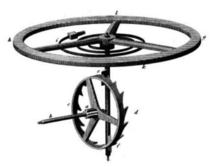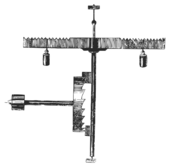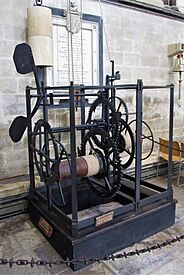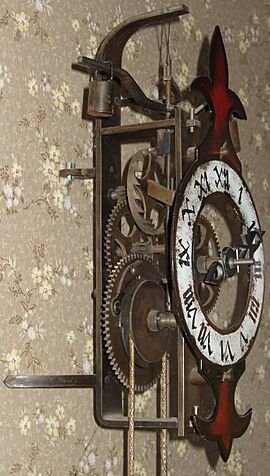Verge escapement facts for kids
The verge escapement is the oldest type of mechanical escapement. This part helps a mechanical clock keep time. It lets the gears move forward in regular steps, making the clock "tick." Verge escapements were used in clocks and pocketwatches for hundreds of years, from the late 1200s to the mid-1800s. The word "verge" comes from a Latin word meaning "stick" or "rod."
This invention was very important in the history of technology. It made it possible to build the first clocks that ran purely by machine. Before this, people measured time using things like water clocks. These worked by water flowing continuously. The verge escapement changed this to using things that swing back and forth, like pendulums. This made timekeeping much more accurate. Most modern timepieces still use parts that swing to keep time.
Contents
How the First Mechanical Clocks Worked
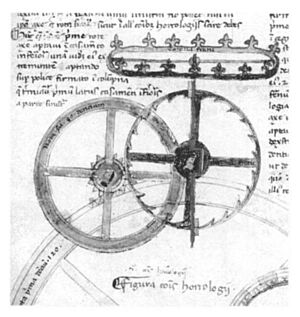
The verge escapement first appeared in Europe in the 1200s. Its invention led to the creation of the very first mechanical clocks. Starting in the 13th century, large tower clocks were built. You could find them in town squares, cathedrals, and monasteries across Europe.
These early clocks used the verge escapement to power a foliot. A foliot was a simple type of balance wheel. It was a horizontal bar with weights on its ends. This bar was attached to a vertical rod called the verge. The verge could swing freely. The verge escapement made the foliot swing back and forth. Clockmakers could change how fast the clock ran by moving the weights closer or further from the center of the foliot.
Historians believe the verge escapement was first used in tower clocks in the late 1200s. This created the first mechanical clocks. It's hard to know exactly when this happened. Many early records used the same word, horologe, for both mechanical clocks and water clocks. Also, none of the very first clock mechanisms have survived exactly as they were built.
One possible early mechanical clock was at Dunstable Priory in England, built in 1283. Another was in Milan, Italy, in 1335. Even though the exact date is debated, it's clear that mechanical clocks existed by the end of the 13th century.
For about 200 years, the verge escapement was the only one used in mechanical clocks. It worked with either a foliot or a balance wheel. In the 16th century, other escapements started to appear. But the verge remained the most common for 350 years. Then, in the mid-1600s, new inventions like the pendulum and the anchor escapement became popular.
Many old verge clocks were updated to use the more accurate pendulum. Because of this, very few original verge and foliot clocks exist today.
The first verge and foliot clocks were not super accurate. Some estimates say they could be off by one or two hours a day. However, modern tests show they could be accurate to within minutes a day if built and cared for well. Early verge clocks were likely not more accurate than water clocks. But they didn't need water refilled, didn't freeze, and offered more chances for new ideas. By the mid-1600s, the best verge and foliot clocks were accurate to about 15 minutes a day.
Verge Clocks with Pendulums
Most of the problems with early verge and foliot clocks came from the foliot itself. It wasn't the escapement's fault. When pendulums were first used in clocks around 1656, the accuracy of verge clocks greatly improved. They went from being off by hours a day to only minutes a day.
Many old clocks had their foliots replaced with pendulums. This is why it's hard to find original verge and foliot clocks today. A similar jump in accuracy happened in verge watches. This was after the balance spring was invented in 1658.
How the Verge Escapement Works
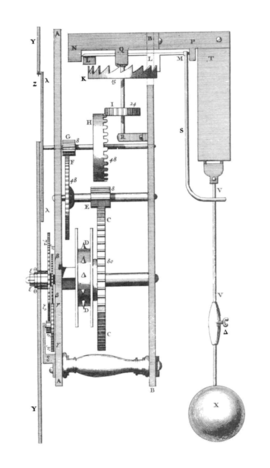
The verge escapement has a wheel shaped like a crown. It's called the escape wheel. It has teeth that stick out towards the front. Its axle is horizontal. In front of it is a vertical rod, which is the verge. The verge has two metal plates called pallets. These pallets catch the teeth of the escape wheel on opposite sides. The pallets are not parallel. They are angled so that only one catches a tooth at a time.
At the top of the verge is a part that swings. This is called an inertial oscillator. It's either a balance wheel or, in the oldest clocks, a foliot. This part is what keeps the clock's time.
As the clock's gears turn the crown wheel, one of its teeth catches a pallet. This pushes the verge and foliot in one direction. It also moves the second pallet into the path of the teeth on the other side of the wheel. The tooth then slides off the first pallet, letting it go. The crown wheel then turns a short distance. Then, a tooth on the opposite side of the wheel hits the second pallet, pushing it. This makes the verge rod and foliot swing back the other way. The cycle then repeats.
This process changes the spinning motion of the wheel into the swinging motion of the verge and foliot. Each swing of the balance wheel lets one tooth of the escape wheel pass. This moves the clock's gears forward by a set amount. This makes the hands move at a steady speed. The way the foliot or balance wheel swings controls how fast the clock ticks. The escape wheel tooth pushes the pallet with each swing. This gives the foliot energy to keep it swinging back and forth.
In a verge pendulum clock, which came after the pendulum was invented in 1656, the escapement was turned 90 degrees. So, the verge rod was horizontal, and the escape wheel's axle was vertical. In the first pendulum clocks, the pendulum was attached to the end of the verge rod. Later pendulum clocks had the pendulum hanging from a spring. A vertical arm from the verge rod had a fork that held the pendulum rod. This reduced friction. Each swing of the pendulum released an escape wheel tooth.
The escape wheel must have an odd number of teeth for the escapement to work. If it had an even number, two teeth would hit the pallets at the same time, stopping the clock.
Challenges of the Verge Escapement
The verge escapement was one of the first, so it had some drawbacks. It was not as accurate as later escapements. Here are some of its problems:
- Sensitive to power changes: Verge watches and clocks would slow down as their mainspring unwound. This is called a lack of isochronism. It was a bigger problem in verge and foliot clocks. The crown wheel teeth are always pushing on the pallets. This means the timekeeping part never swings completely freely. So, if the power pushing it gets weaker, it swings more slowly. All verge watches and spring-driven clocks needed a fusee. This part helped to make the mainspring's power even.
- Recoil: The swinging foliot or pendulum could push the crown wheel backward for a moment. This made the clock's gears move backward a little bit. This caused more friction and wear. You can sometimes tell if an old watch has a verge escapement by watching the second hand. If it moves backward a little with each tick, it might be a verge.
- Wide swings: In pendulum clocks, the verge needed the pendulum to swing in a very wide arc. This caused more errors in timekeeping.
- Air friction: The wide pendulum swings also caused a lot of air resistance. This made the pendulum less accurate. It also needed a lot of power to keep it going, which caused more wear. So, verge pendulum clocks had lighter weights on their pendulums, which also reduced accuracy.
- Wear and tear: Verge timepieces tend to speed up as the crown wheel and pallets wear down. This was especially true for thinner verge watches made in the mid-1700s. To make them thin, the crown wheel had to be very small. This made the effects of wear much worse.
The Decline of the Verge Escapement
Verge escapements were used in almost all clocks and watches for 400 years. But in the mid-1600s, the invention of the pendulum and balance spring made people focus on how to make clocks even more accurate. By the 1820s, better escapements had replaced the verge. However, cheaper verge watches continued to be made through the 1800s.
In pocketwatches, the verge escapement had two main problems. It wasn't very accurate, and its vertical crown wheel and bulky fusee made the watches thick. French watchmakers started using the thinner cylinder escapement, invented in 1695. In England, high-end watches used the duplex escapement, developed in 1782. But less expensive verge watches with fusees were still made until the mid-1800s. Then, the lever escapement took over. These later verge watches were sometimes called 'turnips' because they were so bulky.
The verge was only used for a short time in pendulum clocks. It was quickly replaced by the anchor escapement, invented around 1660. This new escapement became widely used starting in 1680. The problem with the verge was that it made the pendulum swing in a wide arc (80 to 100 degrees). Christiaan Huygens showed in 1674 that a pendulum swinging in a wide arc is not very accurate. Its timing changes if the power from the clock mechanism changes even a little.
Even though the verge is not known for accuracy, it can be very precise. The first successful marine chronometers, made by John Harrison in 1759 and 1770, used verge escapements. These clocks were incredibly accurate, off by less than a fifth of a second per day in tests.
Today, you only see the verge escapement in antique clocks or new clocks made to look old. Many old clocks that were changed to anchor escapements are now being "reconverted." This means clockmakers are putting the original style of verge escapement back into them.
See Also
- Galileo's escapement – The first idea for a pendulum clock escapement by Galileo Galilei.
- Dover Castle Clock – The oldest known working clock with its original verge and foliot escapement. It is now in the Science Museum, London.


